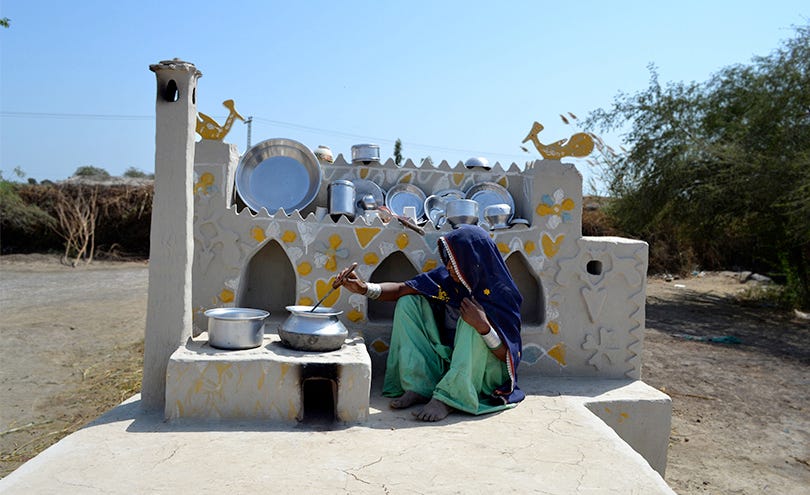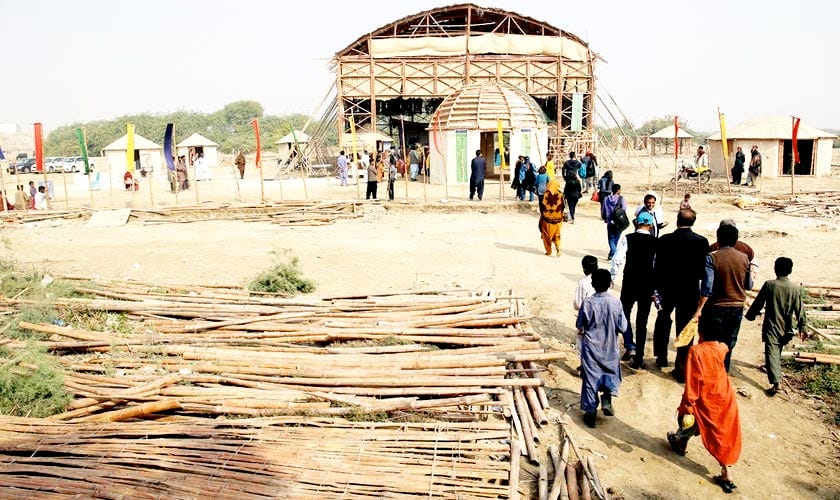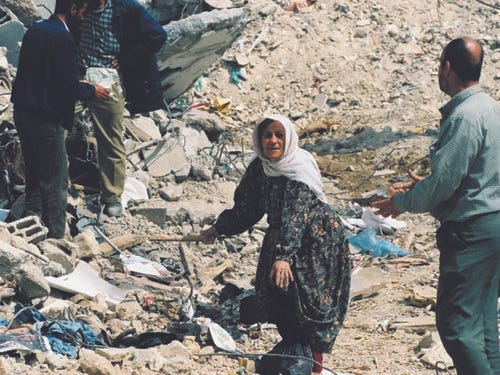The RIBA Gold Medal for 2023 has been given to Yasmeen Lari of Pakistan. She had a conventional corporate architecture career (simultaneously unconventional in that she was a women, the sole registered architect in Pakistan for much of her career) which she left when she no longer found it interesting, and, with her husband Suhail Zaheer Lari, founded the Heritage Foundation of Pakistan in 1980. One of the activities of this foundation is the study of traditional construction methods found in historic buildings and something she calls 'barefoot social architecture' which revives old techniques according to local conditions, and teaches skills that enable people who have lost their houses through environmental disasters, floods, earthquakes and war to rebuild their dwellings.
In the 2005 earthquake on the Jhelum fault line in Azad Jammu and Kashmir, a self-governing area nominally under Pakistan administration, 86-87,000 people were killed, 69-75,000 people injured, 2.8 million people displaced. The scale of reconstruction – of services, of housing, is immense. Lari established programs based on women-centred, sustainable zero-carbon structures, building 40,000 green shelters using bamboo, lime and mud; to date, the largest zero carbon shelter program, and Lari herself the largest provider of shelter.
Western aid agencies such as Oxfam or World Vision are set up to provide emergency care: tents mainly, food aid, Médecins Sans Frontiers medical and logistical teams. However the emergency can extend to years, even generations. Immediacy is slowly eroded, as one can see in ongoing reconstruction in Nepal after its massive 2015 earthquake on the fault line between the Indian Plate and the Eurasian Plate. Seismologists had warned of a repeat of the 1934 Nepal-Bihar earthquake, the potential for geological collapse exacerbated by urbanisation and architecture. One might add to this the attitude that it won't happen again so soon, given that the previous rupture had been in 1505. After the immediate crisis is 'dealt with' by emergency agencies, there is a cascade of further non-geological crises that include the collapse of financial systems, the trafficking of labour, an incapacity to provide enough housing leading to permanent shanty towns and their attendant food insecurity and disease.
It is said that the death toll in Kathmandu was lower than it might have been as the earthquake had happened in the day when people were working outside, rather than at night when they were in collapsing buildings. This seems so serendipitous, pure chance unless one considers the quality of the buildings themselves.
The stories of survival of Ukrainian civilians in basement shelters as their buildings were being bombed overhead, dominated the early coverage of the Russian incursion; slowly other stories are emerging a year later, fatalistic narratives of sleeping outside rather than being crushed in the basement with a whole building collapsing above it. Either way, a resignation to loss of life has set in. Whether by a massive 7.9 earthquake or continuous bombing, architecture and the role of the architect in such catastrophes must be reimagined. Life, in much of the world, is vulnerable, insecure and unsustainable.
Heritage Foundation of Pakistan works on capacity building to enable communities to thrive on their own. Skills are taught and developed allowing marginalised communities to survive, adapt and flourish. One such skill is chulah stove building, developed by Lari as a smokeless clay stove: hygienic, sustainable, that uses less firewood than traditional stoves. Women build their own stoves, then market, build stoves and teach stove-building in other villages.

Such programmes are developed and taught at the Zero-Carbon Cultural Centre in Makli, designed by Yasmeen Lari – a bamboo structure with a curved thatched roof. The flexibility of light structure, akin to the flexing of a grid shell thatched with renewable materials, combines so many weak systems to produce a resilient structure that it bends with perils rather than standing up and shaking a fist at them, as does reinforced concrete and steel girders. So there is bravado in all this: the bravado of technology, inert and massive materials, weight and resistance, versus a certain humility that can, with props and straps, reassemble thin whippy structures when they are blown apart — a different kind of bravado.

Yasmeen Lari queries the efficacy of Western charities such as World Vision, Oxfam, Unesco who swoop in with great refugee tent cities for the displaced. Not only does the Western model remove people from danger and give them shelter, it also removes them from the rubble that is their houses, which they have been picking through, starting the reassembly process, salvaging rebar, bricks. It removes them from the plot of land that their family perhaps has lived on for generations. It removes them from their olive trees. It reorganises their social community, it feeds them at first in communal food stations, such as World Kitchens; they cannot use their own pans. Agency is removed from such people who are, through charitable actions, rendered victims, refugees and vulnerable.
Yet, on news footage one sees whole families, or just single men or women or children, especially in the aftermath of the Turkish/Syrian earthquake, working at the rubble heaps, laying claim to the site of their house or the building they lived in. Now clearly not everyone is able to do this, such disasters come with loss of life, injury and unstable conditions; survivors might be little children or the very elderly, or the infirm, but when the whole affected population of a disaster event is cast into victimhood, it removes even fragmentary autonomy and choice.
In 2004 I presented a paper at a Transportable Architecture symposium at Ryerson. My idea of transportable was not quite the same as the symposium: I was not looking for the better tent, or the more brilliant fold-up shelter that could be dropped from a helicopter, rather I was looking at the disaster relief industry, thriving and growing. Something of the scale of this industry can be seen in the World Habitat Awards established in 1985 by the Building and Social Housing Foundation as part of its contribution to the United Nations' International Year of Shelter for the Homeless in 1987. Awards were, and are, given for ‘practical, innovative and sustainable solutions to current housing needs, and which are capable of being transferred or adapted for use elsewhere.’ There is clearly no end to innovative solutions, there are thousands of them. And with all industries, markets must be created and maintained, thus there is mileage in casting whole populations into a psychological state of neediness and overlooking their capacity for self-renewal.
Yasmeen Lari points out that 'the international colonial charity model' supplies a materials list (often concrete, which is not local) that requires heavy equipment, approved designs and relies on donors who have become increasingly fatigued, given the increasing number of climate change environmental disasters and the intransigence of political conflict. In the 2022 northeast Turkey/adjoining northwest Syria earthquakes, because of the Syrian civil war, aid was not able to access the Syrian catastrophe, and Turkish corruption meant that there were more catastrophic collapses than necessary in a well-regulated building industry. The upshot is that in both situations there was massive loss of life and an incapacity to rebuild. To return to the theme of On Site review 43, the durée of architecture is perhaps not connected with its commodity and delight, but instead its with the firmness of its material culture: a function of building materials, skills and local geographic and environmental knowledge accrued over generations, centuries, millennia. Commodity and delight do not automatically confer safety, or longevity.






"The flexibility of light structure, akin to the flexing of a grid shell thatched with renewable materials, combines so many weak systems to produce a resilient structure that it bends with perils rather than standing up and shaking a fist at them, as does reinforced concrete and steel girders. So there is bravado in all this: the bravado of technology, inert and massive materials, weight and resistance, versus a certain humility that can, with props and straps, reassemble thin whippy structures when they are blown apart — a different kind of bravado." lovely writing (with another kind of bravado)
am intriguing perspective on disaster aid and the model of most charities